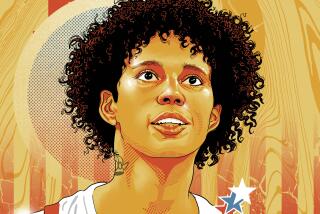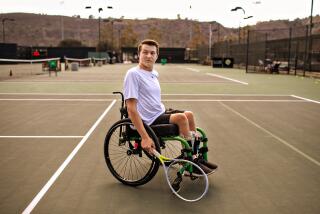Olympic Dream Comes True : Recovery: Ex-volleyball standout Kirk Kilgour, who suffered a disabling injury, will go to the Games as a broadcaster.
- Share via
At 28, Kirk Kilgour was one of the best volleyball players in the world.
Blond-haired, blue-eyed and muscular, the Van Nuys resident had led UCLA to two national championships in the 1970s and was an avid surfer, skier and basketball player. In 1976, he earned a position on the U.S. Olympic volleyball team.
But six months before the Games began in Montreal, Kilgour took an ill-fated leap off a springboard while coaching an Italian volleyball team in Rome. When he landed, he snapped his neck. He was paralyzed.
But now, at 44, Kilgour will make it to an Olympiad as a commentator for NBC at the Summer Games in Barcelona.
“It’s a broadcaster’s dream to do this,” he said. “It’s a player’s dream, too, but this is the way I can be there.”
The accident led to a part-time broadcasting career on cable and network television that he supplements by working as a computer consultant, designing keyboards and other equipment to help the handicapped perform the tasks of daily life.
He is also president of the board of directors of the Independent Living Center of Southern California Inc., a nonprofit agency in Van Nuys that trains people with disabilities to live on their own. At his behest, the center launched an acting program two years ago, branching out in October to painting, music and creative writing.
He suggested the acting program after taking acting classes and learning that performing, like his hard-charging ways on the volleyball court, let him vent his frustrations and built his confidence.
“It feeds that competitive edge,” said Kilgour, who has performed onstage and worked as an extra in a few television shows. “It’s comparable in feel.”
Acting, like sports, has moments of victory and defeat. Or, as Kilgour put it: “I like acting because it’s an industry built on rejection. I like the challenge of it.”
These days, he is confined to a wheelchair, which he controls with a joystick he moves with his chin. But while a student at UCLA, he was lean and strong. One of his favorite photos from those days shows Kilgour, wearing No. 13, spiking a ball, his hair flying. He likes the photo, Kilgour said, partly because a dominant image is his legs, the muscles rippling. He was at the peak of health.
“I led a very charmed life,” Kilgour recalled. “I had a lifestyle most people dreamed of.”
That all changed about 4 p.m. on Jan. 8, 1976.
Kilgour was showing the Italian team how to perform agility exercises on a vaulting horse. Each player bounced off a springboard, pushed off the horse, then flipped in the air before landing on mats.
When his turn came, Kilgour said, he vaulted off the horse and attempted a “daffy” jump, a snow ski maneuver where he stretched out his arms and legs. On his way out of the flip, he realized he was not going to make it and began to tuck his head into his chest.
As Kilgour dipped his head into his chest, he hit the floor and heard a loud crunch. “The crack was so loud, it sounded like someone shot a gun,” he said. He yelled in pain.
Kilgour had dislocated two vertebrae in his neck, severely pinching his spinal cord.
Kilgour said he came to grips with his future as a quadriplegic within a month of the accident. “I realized I’d be paralyzed and I didn’t have a choice,” he said. “I cried one night and knew I would go on. I would be the best I could be in the chair.”
But his disability strained his relationship with his wife of two years. They divorced a few months later.
Yet for all its pains, the 16 years after the accident have shown Kilgour that there is more to life than being an athlete. The acting, public speaking, the broadcasting, his work with fellow disabled people have all been rewarding.
“If somebody said you can walk and be normal, but forget the last 16 years, I don’t know if I would do it,” he said. “It would be a hard decision.”
He can even laugh about his injury. The license plate on his van reads MSTAFLP.
As he adjusted to life in a wheelchair, Kilgour turned to coaching women’s and men’s volleyball. As an assistant coach at Pepperdine University in 1979, Kilgour was watching the filming of “Battle of the Network Stars” on campus and asked a producer if he could get involved in television. They let him audition for a commentator job. He got it.
“I like to be on camera,” he said. “To be a world-class athlete you have to have that ego.”
In 1986, a producer for CBS’ drama “Cagney and Lacey” approached Kilgour to audition for a part of a disabled man who fell in love with Lacey. Kilgour did not get the part. Even so, he had already gotten the acting bug.
“I had never done acting before,” he said. “I came out thinking there could be an opportunity for me as an actor.”
Kilgour enrolled in acting classes at the Mark Taper Forum. His biggest role so far was in a musical, “Available Light,” performed at the Gallery Theater at Barnsdall Art Park in Los Angeles last year. After Kilgour realized how much acting classes had bolstered his self-esteem, he suggested that the Independent Living Center start acting classes for its clients.
Teresa Quintanar, a 23-year-old with a learning disability, is among those who have found the acting therapeutic.
“Sometimes I have trouble expressing things,” she said. “Acting helps me get what’s in here out,” she said pointing to her heart.
During a recent class, Kilgour and Quintanar improvised a scene between former lovers reunited after 10 years.
“How could you leave after all we had?” Kilgour whispered.
“I left you a note explaining why I had to go,” Quintanar said quietly.
Kilgour exploded. “A note?” he yelled. “After everything we had, a note?”
“You wouldn’t listen when I tried to talk to you. . . .”
When the scene ended 10 minutes later, the nine students, some of them in wheelchairs, broke into applause. Kilgour beamed.
More to Read
Go beyond the scoreboard
Get the latest on L.A.'s teams in the daily Sports Report newsletter.
You may occasionally receive promotional content from the Los Angeles Times.






